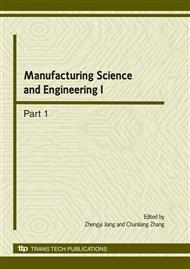p.170
p.176
p.182
p.187
p.191
p.195
p.200
p.204
p.209
Comparative Study of the Process Fracture between Fine-Blanking with Negative Clearance and Conventional Blanking
Abstract:
The different separation mechanism of fine-blanking with negative clearance and conventional blanking under different blanking process are analyzed through fine-blanking with negative clearance and conventional blanking processing experiments on AISI-1045 steel. The fractography photographs in the different deformation regions, such as rollover zone, shearing band, fracture zone and burr zone are scanned by scanning electron microscope (SEM-JSM-6360LV). The place of fracture of fine-blanking with negative clearance has emerged into the middle of work piece not the undermost of workpiece, and the width of fracture band is as tiny as 50-100 micron. The smooth surface formed by the uniform plastic flow in the process fine-blanking with negative clearance, and the full course of finally toughness fracture have been analyzed in the final phase of ejecting in fine-blanking with negative clearance. From the perspective of material meso-damage, the fracture mechanism of special blanking process with negative clearance has been illustrated in details.
Info:
Periodical:
Pages:
191-194
Citation:
Online since:
March 2010
Authors:
Keywords:
Price:
Сopyright:
© 2010 Trans Tech Publications Ltd. All Rights Reserved
Share:
Citation:


